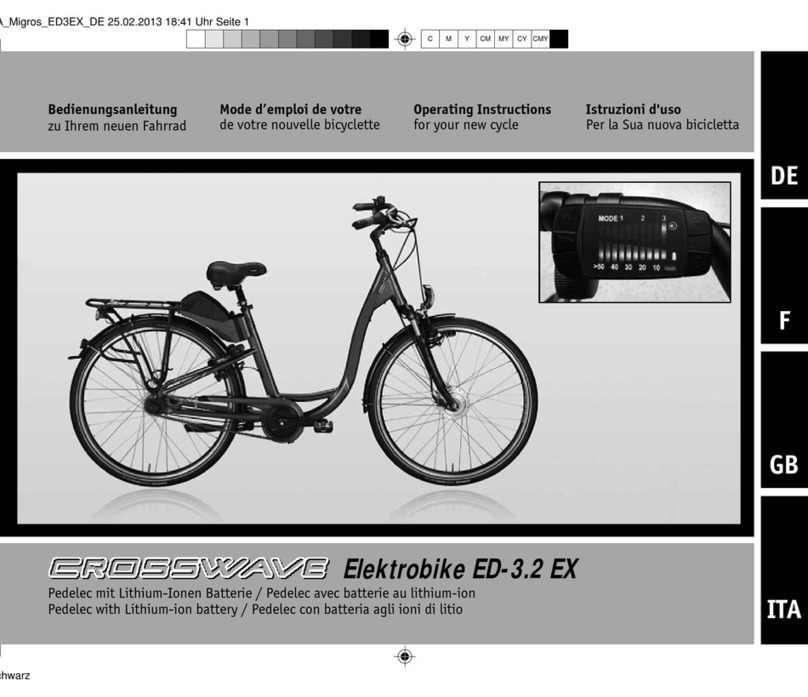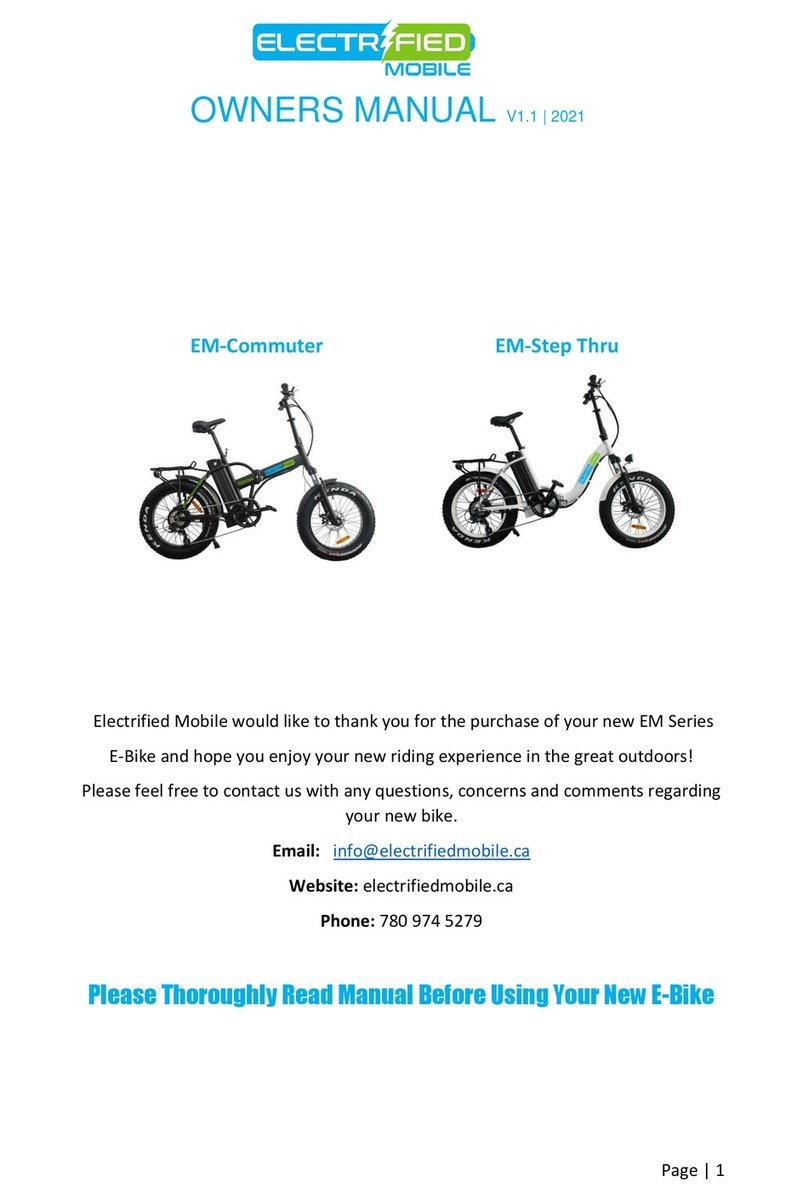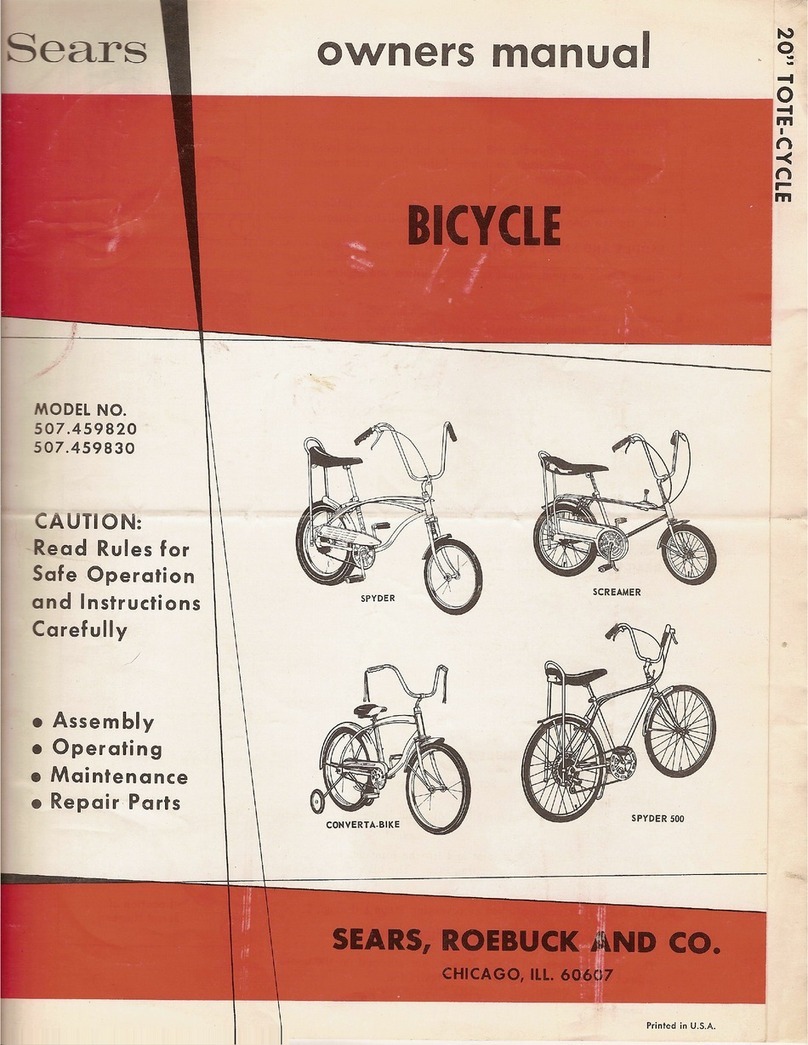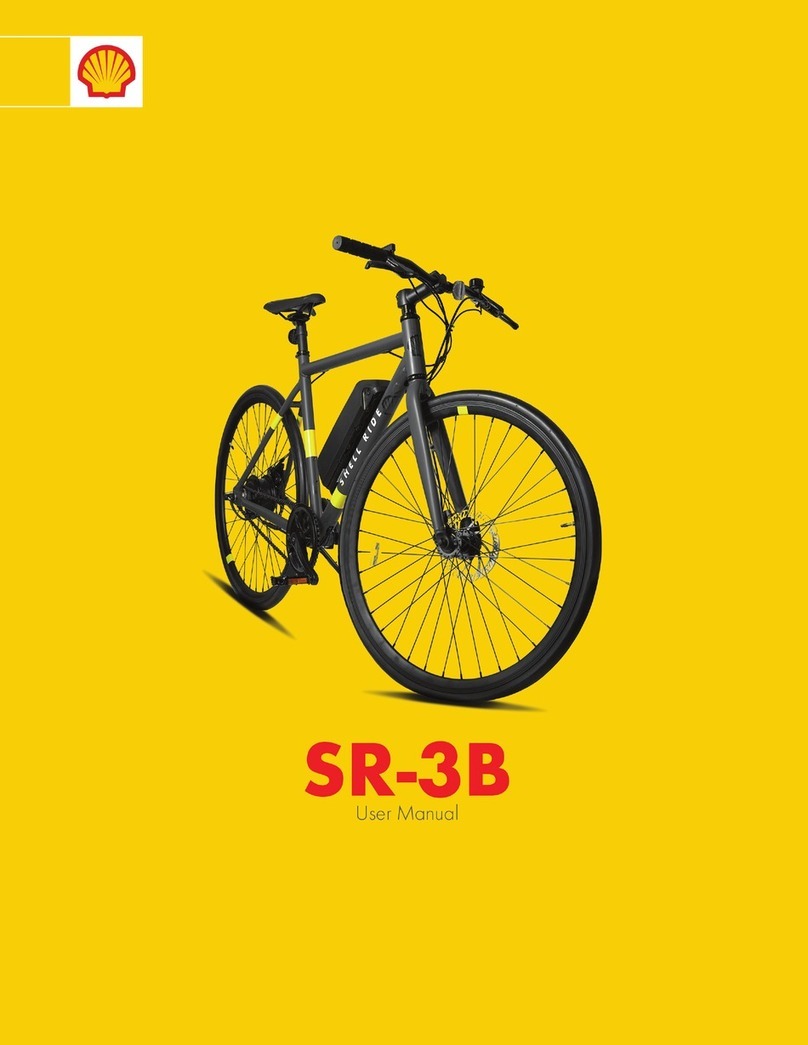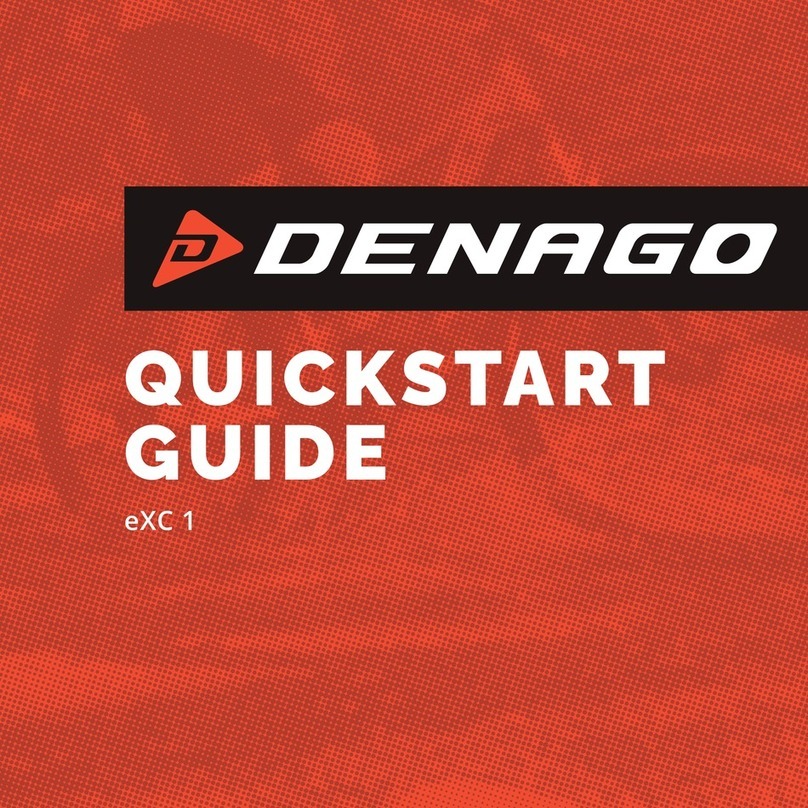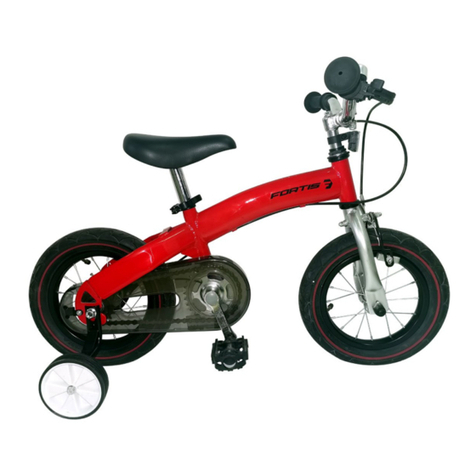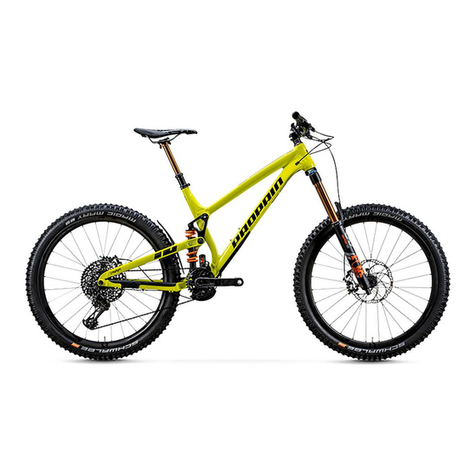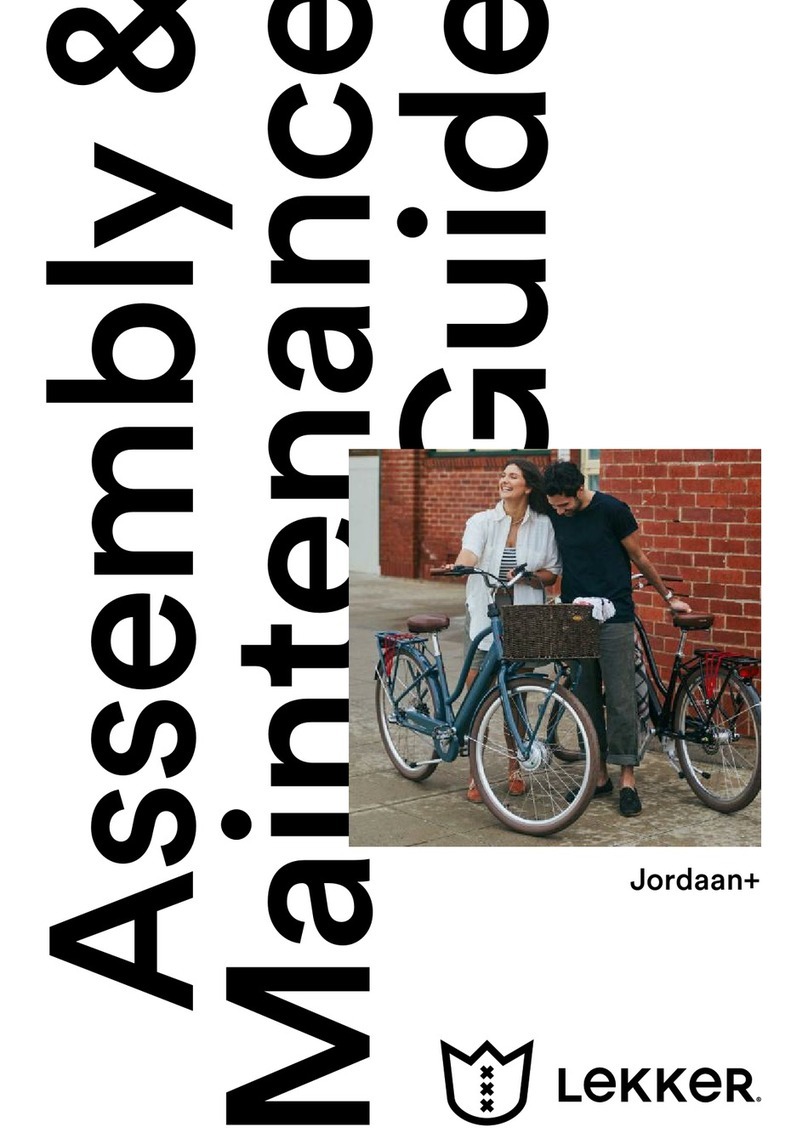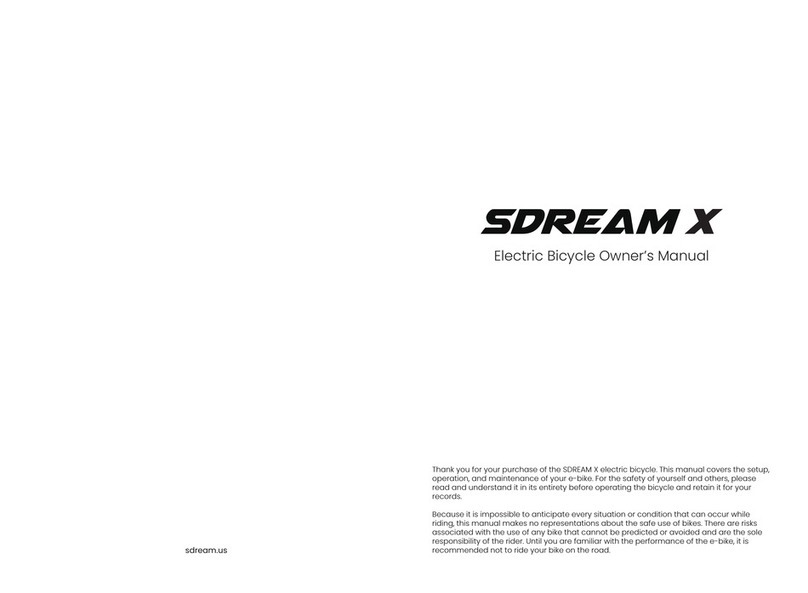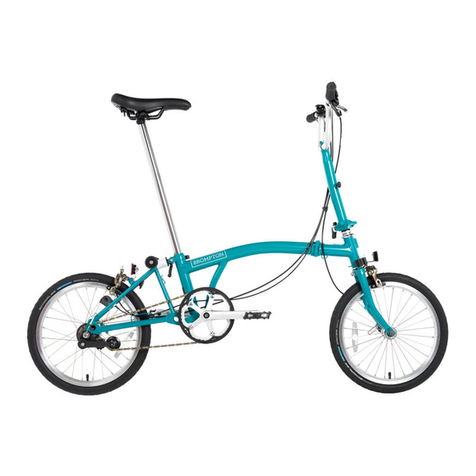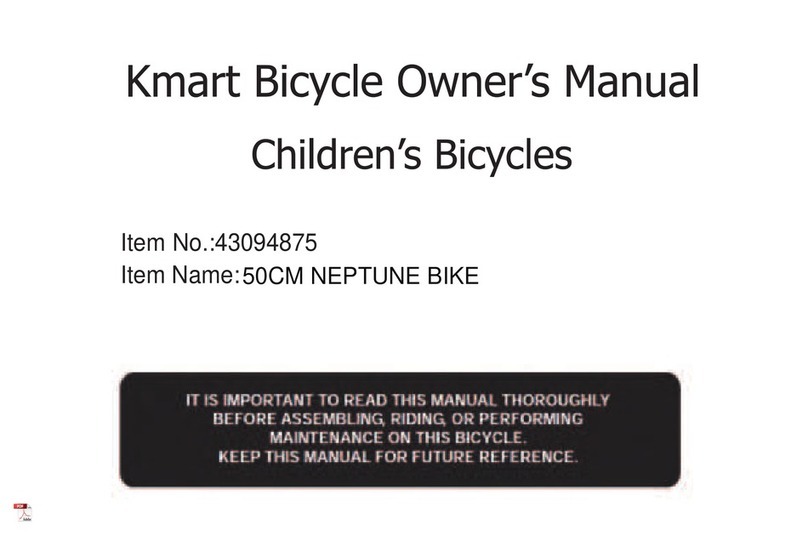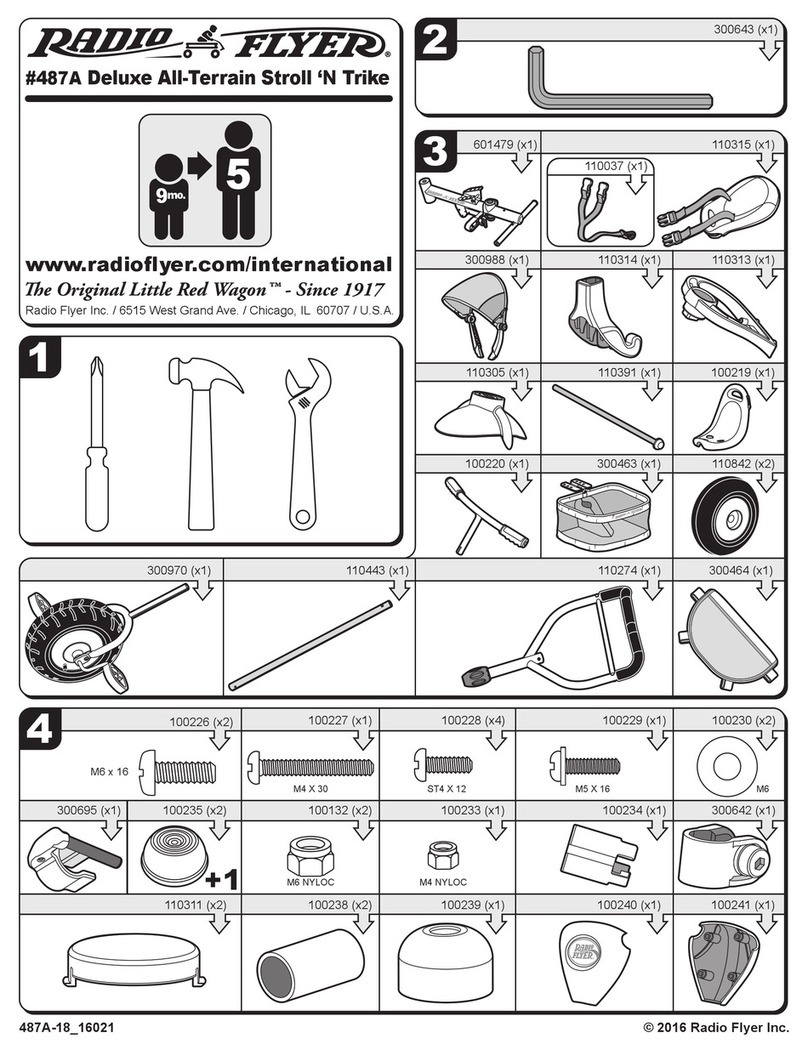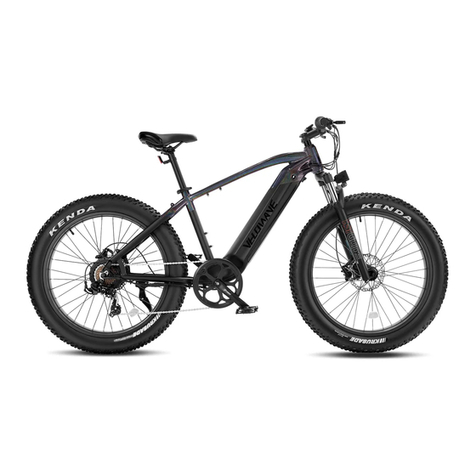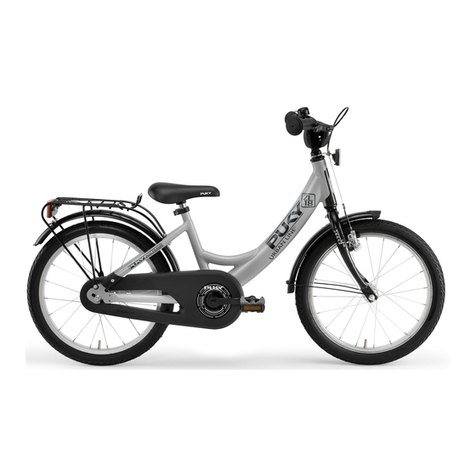Crosswave ED-3 EX User manual

BA_Migros_ED3EX_GB 09.02.2011 12:13 Uhr Seite 1
Probedruck
C M Y CM MY CY CMY K
F
Pedelec with Lithium-ion battery
DE
GB
ITA
Elektrobike ED-3 EX
Operating Instructions
for your new cycle

BA_Migros_ED3EX_GB 09.02.2011 12:13 Uhr Seite 2
Probedruck
C M Y CM MY CY CMY K
98
Bedienungsanleitung
CROSSWAVE Elektrobike ED-3 EX
Pedelec mit Lithium-Ionen Batterie
Mode d’emploi de votre
CROSSWAVE Elektrobike ED-3 EX
Pedelec avec batterie au lithium-ion
Operating instructions
for CROSSWAVE Electro Bicycle ED-3 EX
Pedelec with Lithium-ion battery
Istruzioni d'uso
CROSSWAVE Elektro-Bike ED-3 EX
Pedelec con batteria agli ioni di litio
Operating instructions
ED-3 EX

BA_Migros_ED3EX_GB 09.02.2011 12:13 Uhr Seite 3
Probedruck
C M Y CM MY CY CMY K
- Twix Grip Throttle / Boost-Button 123
- Bike Computer Functions 123
- Menu INFO 132
- Error Messages in the Display 133
Mileage and its factors 134
General operation 135
- Gear 135
- Derailleur 135
- Auxiliary gear with coaster brake hub 135
- Brakes 135
- Coaster brake hub 136
- Hand brake 136
- V-Brake braking 136
- Hydraulic brakes 137
- Roller brakes 137
- Disk brakes 137
Load transportation 137
- Trailer 137
- Front wheel luggage carrier 138
- Rear wheel luggage carrier 138
Servicing instructions 138
- Maintenance of the Pedelec drive 138
- General maintenance instructions 139
- Maintenance in winter 139
Removal of the front wheel 140
Battery return / recycling 141
Technical data 142
Faults / cause / remedy 142
Welcome 100
QUICKSTART 102
Your CROSSWAVE Pedelec and its components 103
Before the first start-up 104
Regular inspections 105
- Inspection schedule 106
Loading the Pedelec / Braking response 106
Proper use of the Pedelec 106
Traffic safety tips 107
Guarantee 107
Wear parts 108
Start-up 110
- Start up of drive battery 110
- Charging the drive battery 113
- Long-term trickle charging 114
Adjustments before a ride 115
- Handle bar and handle bar stem 116
- Brake 117
- Pedals 117
- Lighting system 118
- Handle bar bearing 118
- Spokes 118
- Quick release 119
- Tyres 119
- Rims 120
- Torque specifications 120
Operating the CROSSWAVE Pedelec drive 120
- Recommended method 121
- Display & Funktionen 122
- Pedelec Functions 122
99
Content
GB
Pedelec with Lithium-ion battery

BA_Migros_ED3EX_GB 09.02.2011 12:13 Uhr Seite 4
Probedruck
C M Y CM MY CY CMY K
100
For your own safety, we recommend that you wear a bicycle
helmet while riding the bicycle!
This quality product will be a source of joy wherever you go,
whether for shopping, to office, for leisure, for picnics or as
companion during vacations!
We have taken a lot of care in designing and selecting the
components so that you have the right vehicle for joining the
enthusiastic group of “electrified” bikers!
If you follow the numerous suggestions compiled in this manual,
you can maintain your Pedelec in an optimal condition and
ensure your own safety.
As you have purchased this Pedelec from a dealer, it is guaranteed
that you have received a fully assembled cycle. In case of any
problems or questions associated with repairs, assembly or
accessories, you can always count on professional help.
This user manual is valid for different models of CROSSWAVE
Pedelec. Frame and gear shift can vary. Hence, consider only
those sections that are relevant to your cycle. The technical
Welcome
PanTerra™ – Intelligent Electric!
Dear Costumer,
Thank you for choosing the CROSSWAVE Pedelec – a model with
PanTerra™ drive technology! PanTerra offers the technology for
an easy, alternative mobility. You will enjoy this modern and
eco-friendly mode of travel!
This CROSSWAVE electric bicycle is a so-called Pedelec1, i.e.,
the additional electrical drive assists you up to a speed of 25
km/h while you are pedalling. The technical design of CROSSWAVE
Pedelec complies with the European standard EN15194 for
electric motor-assisted wheels and the European bicycle standard
EN 14764. For driving this Pedelec on public roads in Switzerland,
you must be at least 16 years old or have a driving license of
the M category (motor cycles2). A Velovignette3will take care
of your liability obligation and insurance.
1The newly created term Pedelec consists of the words pedal, electric and cycle,
and denotes a special type of electric cycle that is different from the so-called e-bike,
because law stipulates that its additional drive must work simultaneously with the
paddle drive.
2Traffic Registration Act (VZV), Version on December 5, 2008
3Traffic Insurance Act (VVV), Version on January 1, 2009
Operating instructions
ED-3 EX

BA_Migros_ED3EX_GB 09.02.2011 12:13 Uhr Seite 5
Probedruck
C M Y CM MY CY CMY K
101
GB
design of CROSSWAVE Pedelec complies with the upcoming
European standard EN15194 for electric motor assisted cycles
and with the statutory safety specifications, especially the
European bicycle standard DIN-EN 14764.
Get ready to be electrified!
Your CROSSWAVE Team
CAUTION! In the Operating Instructions, you
find this sign wherever your safety is concerned.
Please inform other users of your cycle about
the safety instructions as well!
Pedelec with Lithium-ion battery

BA_Migros_ED3EX_GB 09.02.2011 12:13 Uhr Seite 6
Probedruck
C M Y CM MY CY CMY K
102
5) Start pedalling. The motor is activated after a half-rotation of
the pedals.
6)
If you are riding this bicycle for the first time, please
try out the available operation modes in low-traffic
areas.
7)
The available operation modes are 1, 2, 3 and 4. The modes
1–3 restrict the max. operational power level. This facilitates
an increase in operating distance.
8)
At the end of the ride, shut off the system by pressing the
"ON/OFF“ button (l.)
9) The CROSSWAVE Pedelec will take you home even on an empty
battery like an ordinary cycle. The battery electronics prevents
an excessive discharge of the battery.
10) Recharge the fully empty Lithium-ion battery after completing
the ride. If the Lithium-ion battery is only partially empty,
continue to use it for subsequent rides till the battery is
completely empty.
11) If you do not use the battery for more than 6 month, recharge
it fully.
Enjoy your drive on the CROSSWAVE Pedelec!
Quick start
Even though you might be eager to use your newly purchased CROSSWAVE
Pedelec immediately, we request you to observe the following steps
without fail before taking your first ride. PanTerra™ will not accept
any guarantee obligations otherwise!
1) Remove all the protective foils from the battery. Please check
the current charging status of your battery by pressing the key
on the LED display (refer to Page 14). The CROSSWAVE Pedelec
is powered by a Lithium-ion battery.
Now charge the battery fully first! Please use the original PanTerra™
Lithium-ion charging device only. Then insert the battery in the
luggage carrier holder and secure the lock (refer to Page 14).
2) Adjust the handle bar and seat; check to ensure that the drive
and brakes function and that all screws, especially the wheel
nuts are properly fixed (refer to Page 17).
3) Switch the system on at the left of the handle bar: Press the
switch to “I” on the control unit. The CROSSWAVE Pedelec is now
ready for a ride. The electronic circuit however is deactivated
after approx. 8 min of inactivity in order to save energy! If
this happens, switch off and then on again.
4)
By activating the four-mode panel, the energy-saving
modes 1–3 can be selected via the Assist button.
Operating instructions
ED-3 EX

BA_Migros_ED3EX_GB 09.02.2011 12:13 Uhr Seite 7
Probedruck
C M Y CM MY CY CMY K
103
Your CROSSWAVE Pedelec and its components
(A) Drive battery
(B) Status display of the drive battery
(C) Lock of the drive battery
(D) Motor control (electronic)
(E) Charging input bushing
(F) Crank with rotary sensor
(G) Front wheel hub motor
(H) Motor plug cover
(I) Handlebars: operational controls
(panel)
Figure 1
GB
Pedelec with Lithium-ion battery
B
A
C
D
E
F
G
H
I

BA_Migros_ED3EX_GB 09.02.2011 12:13 Uhr Seite 8
Probedruck
C M Y CM MY CY CMY K
104
Info:
Ride very carefully in wet conditions. The braking distance
increases if the road is slippery. Under wet conditions, the
braking distance is two or three times as long. Adjust your
manner of driving to the changed conditions. Ride slower and
apply the brakes early.
Switch the lights on under unfavourable conditions of visibility
such as fog, rain, twilight and darkness.
If you leave the public roads, drive only on lanes and never on
open ground. Adjust your speed according to your riding abilities.
Wear tight fitting trousers or use trouser clamps. Wear a helmet
for your own safety. Bright, conspicuous clothing is better seen
under bad visibility conditions.
Do not ride with your hands off the handle bar –
risk of accident and fall.
Before the first start-up
Specifications
Brakes: A cycle must have at least two brakes that function
independently of each other.
Bell: A clear sounding bell is mandatory.
Lights: Both bulbs must function simultaneously. The centre
of the light beam of the front bulb should fall on the road at
a maximum of 10 m ahead of the cycle. The rear light must be
mounted at a height of minimum 25 cm above the road surface.
Reflectors: A white reflector with a large surface area at the
front that can be combined with the headlight. In the rear, at
least one red reflector should be installed. Optionally, the rear
light can be combined with a spot light. Two yellow pedal
reflectors per pedal – one towards the front and one to the
rear! A parking light or a battery light can be installed
additionally.
Special rules for sports cycles
The following special rules are applicable for racing and mountain
bikes: Headlights and taillights can be battery-operated. They
need not be mounted permanently on the cycle, but must be
used when the light conditions so demand. Nevertheless, sports
bicycles must have reflectors. The provisions are not applicable
to official tournaments, provided these take place on cordoned
off roads.
Warning Note: Carry out repairs, servicing or
adjustments on your bicycle only if you have the
requisite knowledge and tools! For your safety,
please assign all repair jobs on your bicycle to a
specialized workshop or to the Service Department
in case of doubt. Components that are bent or
damaged due to accidents or improper handling
must be replaced immediately to avoid the risk of
breakage – e.g., frame, fork, handle bar, handle
bar stem, seat support, pedals or crank arms.
Operating instructions
ED-3 EX

BA_Migros_ED3EX_GB 09.02.2011 12:13 Uhr Seite 9
Probedruck
C M Y CM MY CY CMY K
105
GB
Before the first start-up:
Your cycle was tested several times during manufacture and
subjected to a final control. Since during transportation of the
cycle the settings can change, please check the following without
fail before each ride:
Info:
– Proper mounting of the wheels and quick release levers.
– The minimum insertion depth of handle bar stem and seat
support and their mounting.
– Effectiveness and adjustment of the brakes.
– Adjustment and bolting of the spring components.
– Function of the gear and the lights.
– Safe seat of all screws, nuts and the pedals.
– The air pressure and the profile depth of the tyres.
Regular inspections
Check periodically, e.g., after 300–500 km or every 3–6 months,
depending on the intensity of use of the cycle to ensure that
all screws, nuts and the quick release are fixed properly. Check
or service for the first time after approximately 100 km. Checks
or servicing is thereafter necessary at regular intervals. The
indicated amount of kilometres gives only a rough orientation.
You have to take into account the use pattern and the number
of kilometres driven in rain. In addition to the jobs that you
undertake during the regular inspection, please
– Clean cycle and oil moveable components.
– Treat paint rub-offs and rusted areas.
– Apply protective coating on metal parts.
– Replace non-functional or damaged parts.
IMPORTANT NOTE: Caution! To be able to undertake
all the jobs on your cycle on your own, you will need
some experience, suitable tools and skills. While
tightening the screws, please pay attention to the
correct tightening torques. These are given on Page
22 of this Operating Instructions or in the
instructions of the component manufacturers.
Difficult and safety-related jobs are better to be
done by an expert.
Pedelec with Lithium-ion battery

BA_Migros_ED3EX_GB 09.02.2011 12:13 Uhr Seite 10
Probedruck
C M Y CM MY CY CMY K
Loading the Pedelec
– The permissible total load (rider and luggage) on the
CROSSWAVE Pedelec is 120kg.
– The permissible load of the luggage carrier is mentioned on
the luggage carrier.
– If your cycle is equipped with a front basket, the additional
load allowed here is 5kg.
Braking response
– Use the front wheel brake carefully on wet, sandy and slippery
roads, wet asphalt and ice, to keep the front wheel from
skidding and to retain the Pedelec under control!
– The brakes must be used with care. Blocked wheels have
a reduced braking effect and can lead to loss of balance
and fall!
– As a matter of principle, do not apply the brakes in curves
but before them; braking increases the risk of skidding!
– The braking lever mounted on the handle bar must always be
tight. Check regularly to ensure that they are not loose,
and tighten if necessary.
– Work on the brake system should be entrusted exclusively
to the dealer!
Proper use of the Pedelec:
Your Pedelec has been designed and equipped like a bicycle for
the use on public roads and paved lanes. Please bear this in
mind when using the Pedelec under off-road conditions and in
case of overloading and improper rectification of faults.
When? Servicing / check Action
After approximately
100 km and
subsequently at least
1x per annum
Check the tightening torque
of screws, cranks, pedals,
handle bar, seat support and
seat. Adjustment of gear,
control set, spring elements
and brakes. Check the wheels
and tyres
Customer Service,
Service Department
or specialized
workshop
After every ride Check the rims, spokes, tyres,
bell, brakes, quick release,
lights and the function of the
gear and springs
Check the rims for
concentricity and
wear marks. Check
tyres for foreign
bodies
Regularly after
300–500 km Check the cranks, sprocket
wheel and pinion. Check
chain wear and tear, stability
of all screws, wear indication
on the rim
Clean and apply
chain grease
After 1000 km Back pedal brake, VR-HR
hubs Dismantle, clean and
apply grease. Check
brake jacket, replace
if necessary
After 3000 km Control set, pedals, hubs,
brake and control wires*) Let Service check,
dismantle, clean,
lubricate and replace
if necessary
After rain Chain, brake, wiring Clean, lubricate
* Do not oil Teflon coated cable jackets!
106
Operating instructions
ED-3 EX

BA_Migros_ED3EX_GB 09.02.2011 12:13 Uhr Seite 11
Probedruck
C M Y CM MY CY CMY K
GB
Guarantee
1) Guarantee: Your decision to buy a cycle from our company entitles
you to own a top quality product. Migros gives you a guarantee of 2
years.
2) The guarantee does not cover the following:
– All damages attributable to improper use and application of force
(refer to information about proper use of the Pedelec).
– Components of the cycle that are subject to use-related wear and
tear, unless there are production faults or material defects. (Refer
to list of possible wear parts on Page 12).
– Damages to the cycle attributable to improper or faulty maintenance
and to unprofessionally executed repairs, alterations or replacement
of parts. Detailed servicing or maintenance instructions are given in
this Operating Instructions.
– Accident damages or other such unusual external effects, unless
these are attributable to improper information or product faults.
– Repairs made with used parts or damages ensuing there of.
– Damages on account of use of the product in competitions.
(Refer to information about proper use of the Pedelec according
to manufacturer instructions).
– For subsequent attachments that were not a part of the delivery
scope of the product on the hand over date, or damages that occur
on account of unprofessional assembly of these attachments.
Info: For valid warranty claims, the buyer must present the original
purchase receipt to the vendor.
Caution! Traffic safety tips:
> Always observe the traffic rules.
> Drive carefully. Do not endanger or provoke other vehicle
drivers.
> Switch the lights on early if it is getting dark.
> Cycling is prohibited on the highways. Danger to life!
> Keep sufficient distance from automobiles in front; these
normally have a shorter braking distance.
> Wear bright clothes so that you are detected early.
> Always wear a helmet.
> Ensure that your cycle is always in roadworthy condition.
> Children below 6 years should always use the footpath. Children
must always climb down from the cycle before crossing a
traffic lane. For reasons of safety, the rider must avoid listening
to music with headphones in the midst of vehicular traffic.
Caution! Learn the traffic rules before venturing out onto
busy roads. Learn to anticipate the errors of other drivers!
> Please ride only on the designated lanes and roads, not over
meadows and fields or across forests.
> Never ride the bicycle through water.
> Pay attention to pedestrians and hikers; your hands should
be ready to apply the brakes at blind curves/corners and while
riding downhill, pay attention to your speed and do not leave
any skid marks.
Caution! Riding in the open fields requires a lot of skill, good
fitness and high concentration. Start with easy tours and
increase your difficulty level gradually.
107
Pedelec with Lithium-ion battery

BA_Migros_ED3EX_GB 09.02.2011 12:13 Uhr Seite 12
Probedruck
C M Y CM MY CY CMY K
2) Rims in connection with rim brakes
Not only the brake pad but also the rim is subjected to use
related wear on account of the interaction between the rim
brake and the rim. Hence, the rim should be checked at regular
intervals for wear and tear. The occurrence of fine cracks or
deformation of the rim horns when increasing the air pressure
indicates heavy wear and tear. Rims with wear indicators enable
the rider to detect the wear condition of the rim easily.
3) Brake pads
The brake pads for rim brakes, drum brakes and disk brakes are
subject to use related wear and tear. This depends on the use
of the cycle. Riding the cycle in rough or hilly terrain or using
it for sports activities can necessitate the replacement of the
brake pads at shorter intervals. Check the wear condition of the
covers and let your service partner replace them.
4) Chains and drive belts
The cycle chain is subject of use related wear and tear. The
extent of the wear depends on the servicing and maintenance
and the type of use of the cycle (mileage, riding in rain, dirt
and pollution, salt etc.). Regular cleaning and oiling can increase
the life, but replacement is necessary on reaching the wear limit
(approximately 2000–3000 km).
Parts subjected to regular wear and tear
Please note: List of parts subjected to regular wear and tear
1) Tyres
2) Rim in connection with rim brake
3) Brake jackets
4) Chain and drive belt
5) Sprockets, pinions, inner bearings and transmission rollers
6) Bulbs and lighting system
7) Handle bar tapes / handle covers
8) Hydraulic oils and lubricants
9) Gear and brake jackets
10) Paint
1) Tyres
The cycle tyres are subject to use related wear and tear. The
extend depends on the use of the cycle and can be influenced
to a great deal by the rider. Sharp braking that leads to the
blocking of the tyre reduces the life of the tyre significantly.
Moreover, the air pressure should be checked regularly and if
necessary, increased to the value specified by the tyre
manufacturer. Excessive exposure to the sun, petrol, oils etc.
can damage the tyres.
108
Operating instructions
ED-3 EX

BA_Migros_ED3EX_GB 09.02.2011 12:13 Uhr Seite 13
Probedruck
C M Y CM MY CY CMY K
GB
5) Sprockets, pinions, inner bearings and transmission rollers
In cycles with derailleur, the pinion, sprockets, inner bearings
and transmission rollers are subject to use related wear and
tear. Regular cleaning and lubrication can increase their life,
but replacement is necessary on reaching the wear limit. The
extent of wear depends on maintenance, servicing, the type of
use of the cycle (mileage, riding in the rain, dirt and pollution,
salt etc.).
6) Bulbs of the lighting system
Light bulbs and other lamps are subject to use related wear.
Hence, replacement may be necessary. The user must always
carry spare light bulbs to enable timely replacement.
7) Handle bar tapes and handle covers
Handle bar tapes and handle covers are subject to use related
wear. Replacement may be necessary regularly for this reason.
Ensure that the handles are connected tightly to the handle
bar.
8) Hydraulic oils and lubricants
Hydraulic oils lose their efficacy in the course of time. All
lubrication points should be cleaned regularly and re-lubricated.
Non replaced lubricants increase the wear in the attached parts
and bearings.
9) Cable and brake housing
All Bowden housings must be serviced regularly and replaced
if necessary. This can be the case especially if the cycle is placed
in the open frequently and is exposed to weather influences.
10) Paintwork
Paintwork requires regular maintenance. Check all painted
surfaces regularly for damages and rectify them immediately.
This will also preserve the good look of your cycle.
109
Pedelec with Lithium-ion battery

BA_Migros_ED3EX_GB 09.02.2011 12:13 Uhr Seite 14
Probedruck
C M Y CM MY CY CMY K
Start-up of the CROSSWAVE Pedelec
The following chapters of the user manual of the CROSSWAVE
Pedelec presume that all basic ergonomic settings and necessary
safety checks of your bike have already been done:
– Handle bar and seat have been brought to the desired position
and tightened appropriately.
– The wheels have sufficient tyre pressure and their axle nuts
have been tightened too.
– The function of the brakes and pedal drive has been checked.
– The lighting system is functioning.
For more information refer to the Chapter
“Adjustments before ride”.
Start-up of the drive battery:
Now take the drive battery out of the holder in the luggage
carrier of the CROSSWAVE Pedelec. Remove any protective foils
– especially the ones on the electrical contacts located at the
lower end.
Now check the charging state of the battery
by pressing the key on the LED-charging status
display. If less than two LEDs or no LED lights
up, the battery may be damaged. In this case
please contact your dealer.
110
Operating instructions
ED-3 EX

BA_Migros_ED3EX_GB 09.02.2011 12:13 Uhr Seite 15
Probedruck
C M Y CM MY CY CMY K
Check the charging status of the battery. To do this, press the
knob at the LED display on the top side of the battery. Refer to
Figure 2
Figure 2
If all the 5 LEDs do not light up, PanTerra™ recommends that
you first charge the battery fully.
To do this, connect the drive battery to the charging device
included in the scope of delivery. Refer to the Chapter “Charging
the drive battery” on Page 113.
The compartment for the battery-fuse is located on the side.
(cover with symbol ).
Slide the battery into the support slot on the Pedelec as
demonstrated in Graphic 4 and 5. Ensure that the contact pins,
which are fixed into the support slot, slide smoothly into the
connectors of the battery. GB
Lithium-ion batteries get self-discharged much
slower than Nickel batteries and can therefore be
stored for approximately 6 months without
recharging. However, if the battery is not recharged
after this period, the chemical structure can be
damaged, which affects the performance of the
battery considerably and can make it unusable.
111
Pedelec with Lithium-ion battery

BA_Migros_ED3EX_GB 09.02.2011 12:13 Uhr Seite 16
Probedruck
C M Y CM MY CY CMY K
The key can be removed in both the locked
and unlocked position! PanTerra™ recommends
that the key is always removed!
This ensures that neither can the lock
accidently open by itself with the battery
falling out nor can the key be lost.
The CROSSWAVE Pedelec
is now ready to go!
The battery should now be firmly positioned in the support slot
as demonstrated in Graphic 3. The push cylinder lock should be
cleanly locked into the battery housing.
Figure 3
Locking the battery ensures that it is firmly held so that damage
caused through vibration is prevented; thereby guaranteeing
that optimal electrical contact is maintained between the battery
and the electronics of the Pedelec.
Figure 4
112
Operating instructions
ED-3 EX

BA_Migros_ED3EX_GB 09.02.2011 12:13 Uhr Seite 17
Probedruck
C M Y CM MY CY CMY K
Charging and care of the battery
The ED-3 EX Pedelec operates with a 37V 8.8Ah lithium-ion
battery. PanTerra™ uses top-quality cells which are combined
into a 37V cell pack. In addition, the battery also contains an
electronic protection system which prevents deep discharging
and overcharging.
Avoid storing a completely empty battery over several weeks.
Always use the high-quality lithium-ion charger supplied (Graphic
6) or the corresponding original PanTerra™ replacement part
for charging your battery. The original charger operates using
CC-CV4technology. In conjunction with the battery’s electronic
protection system, the possibility of any damage occurring to
the battery at any time can therefore be ruled out as can any
possibility of overcharging through an incorrect charging current.
The charger is for indoor use only! Please read the charger
manual attached prior to initial use.
Remove the charger (Graphic 6) from the box, loosen the bundle
of cables and connect it to the multi-pole charging socket
located on the side of the battery. A rubber cover protects it
from spray.
The battery can also be charged on the bicycle.
Figure 5
Connect the charger
to the mains socket
using the mains cable
supplied. The LED of
the charger changes
from green to red.
Charging begins.
4CC-CV = Constant Current – Constant Voltage: Controlled current strength is first used
to charge quickly and the battery voltage increases. On approaching the maximum
capacity, the current strength is reduced and the remaining capacity is filled only with
exact maximum specified voltage.
Figure 6
GB
113
Pedelec with Lithium-ion battery

BA_Migros_ED3EX_GB 09.02.2011 12:31 Uhr Seite 18
Probedruck
C M Y CM MY CY CMY K
If the battery pack is nearly full (95%), the LED changes from
red to yellow. The first phase of charging has been completed.
The battery pack can be taken out of the charger at any time.
A full charge can require up to nine hours (CC-CV charging
means that after 5.5hours, approximately 95% of the charge
has been completed. It can be estimated that a further four
hours are still required for the remaining 5% capacity in the
slow CV-mode).
Long-term trickle charging:
Lithium-ion batteries do not receive any long-time trickle
charging. Their self discharge is too low and the associated
charging devices therefore are not designed for it.
It is therefore not recommended to connect the battery to the
charging device continuously over a prolonged period of absence
especially in winter. The safety electronic circuit in the battery
will prevent any damage, but the charging device would be
working all the time.
Danger of short circuit! Ensure that no metallic
objects come close to the battery contacts and
the charging plug.
The battery should not be charged at very high and very low
temperatures (below -10 °C and above +40 °C). We recommend
that the cycle should not be exposed to bright sunlight during
charging.
Electrical devices should not be connected to the
mains over long periods without supervision. Hence,
you should pull out the power plug from the mains
socket during vacations or during long periods of
absence.
Tip:
If you do not use the Pedelec for long intervals, please recharge
the Lithium-ion battery once every six months. Pull out the
fuse from the battery during storage to rule out consumption
of electricity (very little) by the protective electronic circuit
itself. Of course, you must reinsert this fuse before charging
again.
114
Operating instructions
ED-3 EX
Steady green light Charging completed/no battery
Steady red light Normal charging (CC) 0–95%
Flashing green normal Charging (CV) 95-100%
Flashing green Charging completed
ModeCharging device LED

BA_Migros_ED3EX_GB 09.02.2011 12:13 Uhr Seite 19
Probedruck
C M Y CM MY CY CMY K
GB
Adjustments before a ride
Check the following before each ride
– All screws, wheel nuts or quick release are tight
– The brakes function
– The air pressure of the tyres is sufficient
– The lighting system is intact
– The bell is OK.
Seat and handle bar:
You bicycle is assembled by the dealer and is in a road-worthy
condition. The handle bar and seat position is adjusted to your
height. While adjusting the seat and handle bar height, pay
attention to the minimum insertion depth marked on the handle
stem shaft and seat support. Never pull out the handle bar or
seat above the marking!
Seat:
The seat can be adjusted in three directions:
height, inclination and distance from handle bar (Figures 7, 8):
Height:
– Loosen the seat clamping bolts (Figure 7 Pos. 1) or quick
release (Figure 8 Pos. 1)
– Move the seat support in or out
– Tighten the clamp after making the adjustment.
You have adjusted the seat height according to your body size,
so that, while sitting on the seat, the tips of your toes touch
the ground on both sides.
Figure 7 Figure 8
Caution! The seat support must remain clamped at
least up to the mark. Otherwise it might break,
leading to a fall! Leather seats can discolour clothes
when used initially under wet conditions. Frequent
re-adjustments of the seat can leave permanent
scratches on the surface of the seat support due to
the mechanical action. These damages fall under
normal wear and tear, and do not constitute a case
of materials defect liability.
Inclination of the seat and distance from handle bar
(Figures 7, 8):
– Loosen the nut of seat piston or inner hexagon bolt (2)
– Move seat forward or backward
– Incline the seat
– Tighten the nut or inner hexagon bolt
115
Pedelec with Lithium-ion battery

BA_Migros_ED3EX_GB 09.02.2011 12:13 Uhr Seite 20
Probedruck
C M Y CM MY CY CMY K
Adjusting the inclination of the handle bar:
– Loosing the joint (Figure 9, 10, pos. 2)
– Rotate to the correct position
– Tighten the joint
Angular adjustment of handle bar stem:
This stem offers more flexibility in adjusting the handle bar
position:
Handle bar and handle bar stem
Figure 9 Figure 10
The handle bar can be adjusted as follows (Figures 9, 10):
Caution! After a fall on the handle bar, you must
replace the handle bar and stem. Invisible micro
cracks can lead to breakage and therefore, pose a
risk of falling!
Adjusting height:
– Loosen the nut or inner hexagon bolt of the expander bolt
(Figure 9, 10, pos.1)
– Loosen the bolt with a gentle hammer blow and adjust the
correct handle bar height.
– Tighten the expander bolt finally.
Caution! Please pay attention to the marking, which
should under no circumstance project out of the
control tube. Danger of breaking – and therefore,
risk of falling! Frequent re-adjustments of the seat
can leave permanent scratches on the surface of
the seat support due to mechanical action. These
damages falls under normal wear and tear, and does
not constitute a case of materials defect liability.
Figure 11
Adjustment:
– Loosen the screw joint.
– Rotate the handle bar to the desired position.
– Tighten the screw joint.
116
Operating instructions
ED-3 EX
Table of contents
Other Crosswave Bicycle manuals

